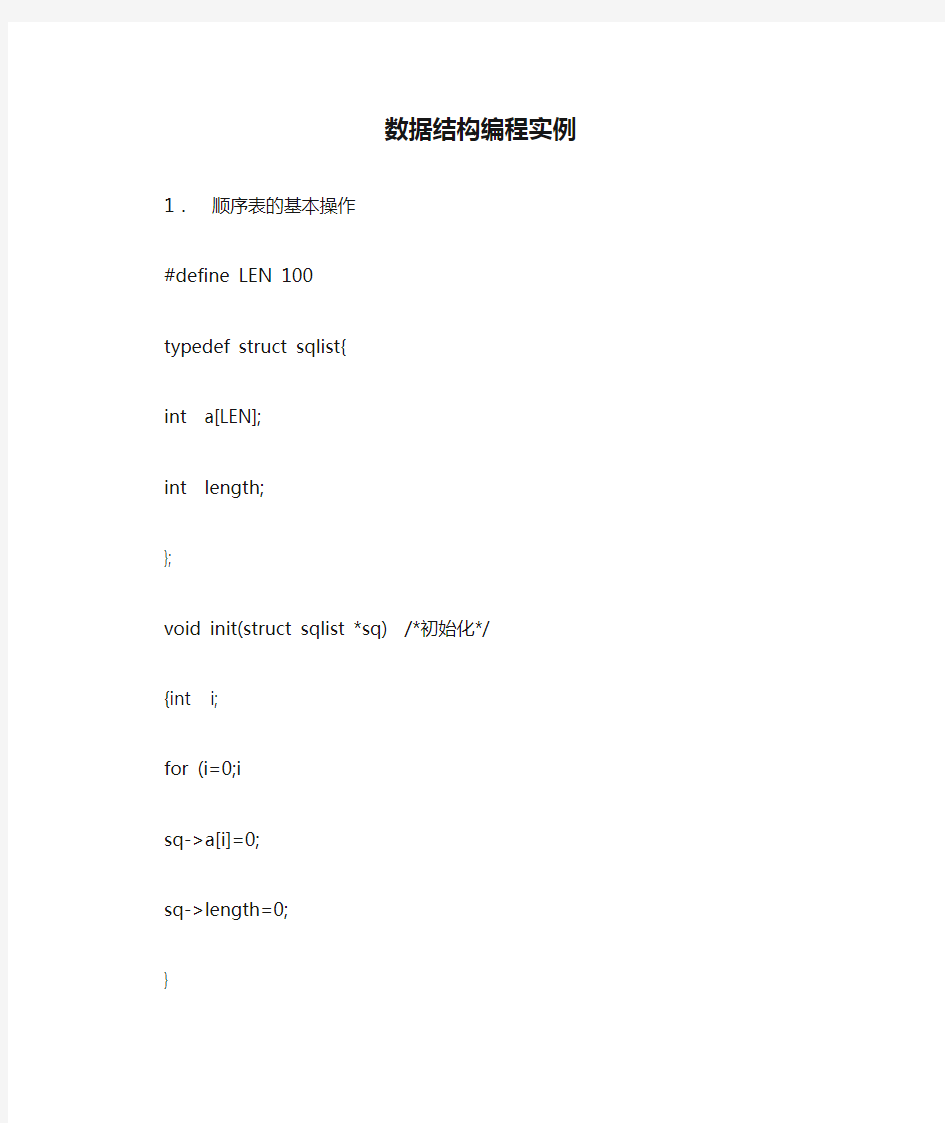数据结构编程实例


数据结构编程实例1.顺序表的基本操作
#define LEN 100
typedef struct sqlist{
int a[LEN];
int length;
};
void init(struct sqlist *sq) /*初始化*/ {int i;
for (i=0;i sq->a[i]=0; sq->length=0; } void creat(struct sqlist *sq) /*建顺序表*/ {int i; printf("please input length"); scanf("%d",&sq->length); printf("please input %d nums\n",sq->length); for (i=1; i<=sq->length;i++) scanf("%d",&sq->a[i]); } void print(struct sqlist *sq) /*输出顺序表*/ { int i; for (i=1; i<=sq->length;i++) printf(" %d",sq->a[i]); printf("\n"); } void insert(struct sqlist *sq,int pos, int x) /*顺序表插入元素*/ {int i; for (i=sq->length;i>=pos;i--) sq->a[i+1]=sq->a[i]; sq->a[pos]=x; sq->length=sq->length+1; } int delete(struct sqlist *sq,int pos) /*顺序表删除元素*/ {int i,x; x=sq->a[pos]; for (i=pos+1;i<=sq->length;i++) sq->a[i-1]=sq->a[i]; sq->length=sq->length-1; return(x); } main() {int position,x; struct sqlist *list; struct sqlist slist; int xz=0; list =&slist; while (1) { printf("1.init\n"); printf("2.creat\n"); printf("3.insert\n"); printf("4.delete\n"); printf("5.locate_value\n"); printf("6.locate_pos\n"); printf("7.print\n"); printf("0.exit\n"); printf("please input your choice"); scanf("%d",&xz); switch(xz) {case 1:init(list);break; case 2:creat(list);break; case 3:printf("pleast input inset position(pos) and value(x)"); scanf("%d%d",&position,&x); if (position<1||position>list->length+1||list->length>=LEN) printf("position error\n"); else insert(list,position,x); break; case 4:printf("pleast input delete position(pos)"); scanf("%d",&position); if (position<1||position>list->length||list->length==0) printf("position error\n"); else printf("delete position=%d,delete data=%d\n",position,delete(list,position)); break;; case 5:; case 6:; case 7:print(list);break; case 0:exit(0); } } } 2.三种方法建立链表 #include typedef struct node {int data; struct node *link;}NODE; NODE *creat1() /*按输入数据的顺序建立链表,输入数据通过个数控制*/ {int i,data,n; NODE *h=NULL,*p,*last=NULL; printf("please input the num:"); scanf("%d",&n); printf("please input %d datas:",n); for (i=1;i<=n;i++) {p=(NODE*) malloc (sizeof (NODE)); scanf("%d",&p->data); if (i==1) h=p; else last->link=p; last=p; } last->link=NULL; return(h); } NODE *creat2() /*按输入数据的逆序建立链表,输入数据以0结束*/ {int data; NODE *h=NULL,*p; printf("please input datas(0 end)\n"); scanf("%d",&data); while (data) {p=(NODE*) malloc (sizeof (NODE)); p->data=data; if (h==NULL) {h=p; h->link=NULL;} else {p->link=h; h=p;} scanf("%d",&data); } return(h); } NODE *creat3() /*按输入数据的大小顺序建立带头结点的链表,输入数据以0结束*/ {int data; NODE *h,*p,*q,*r; h=(NODE*) malloc (sizeof (NODE)); h->link=NULL; printf("please input datas(0 end)\n"); scanf("%d",&data); while (data) {p=(NODE*) malloc (sizeof (NODE)); p->data=data; p->link=NULL; if (h->link==NULL) h->link=p; else {r=h; q=r->link; while (p->data>q->data && q) {r=q; q=q->link;} if (q) p->link=q; r->link=p; } scanf("%d",&data); } return(h->link); } main() {NODE *h,*p; int x; do {printf("=====================\n"); printf("1.zhengxujianlianbiao\n"); printf("2.nixujianlianbiao\n"); printf("3.jianliyouxulianbiao\n"); printf("0.tuichu\n"); printf("=====================\n"); printf("please input your chosice"); scanf("%d",&x); switch(x) {case 1: h=creat1();break; case 2: h=creat2();break; case 3: h=creat3();break; case 0: return; } p=h; while (p) {printf("%5d",p->data); p=p->link; } printf("\n\n"); } while (x); } 3.试写出逆转线性单链表的算法 要逆转一个线性单链表,只需从头指针指向的结点开始扫描该链表,在扫描过程中改变各结点的指针(由指向后件改为指向原来的前件)即可。 Struct node /*ET位数据元素类型*/ {ET d; struct node *next }; invlst(head) struct node **head ; struct node *p, *q, *r ; {if (*head==NULL) return; p=*head; q=p->next; p->next=NULL; while (q!=NULL) {r=q->next; q->next=p; p=q; q=r; } *head=p; return; } 4.设有两个有序线性单链表,头指针分别为AH和BH。试写出将两个有序线性单链表合并为一个头指针为CH的有序线性单链表的算法,要求去掉重复元素。 Struct node /*ET位数据元素类型*/ {ET d; struct node *next }; #include “stdio.h” mglst1(ah,bh,ch) struct node ah,bh,**ch; {struct node *i, *j, *k, *p; et x; i=ah; j=bh; *ch=NULL; k=NULL; while ((i!=NULL)&&(j!=NULL)) {if (j->d>=i->d) {x=i->d; i=i->next;} else {x=j->d; j=j->next;} if (*ch==NULL) {p=(struct node *) malloc (sizeof(struct node)); p->d=x; *ch=p; k=p; } else if (d!=k->d) {p=(struct node *) malloc (sizeof(struct node)); p->d=x; k->next=p; k=p;}}} if (j==NULL) while (i!=NULtructL) {x=i->d; i=i->next; if (*ch==NULL) {p=(struct node *) malloc (sizeof(struct node)); p->d=x; *ch=p; k=p; } else if (d!=k->d) {p=(struct node *) malloc (sizeof(struct node)); p->d=x; k->next=p; k=p; }} else while (j!=NULL) {x=j->d; j=j->next; if (*ch==NULL) {p=(struct node *) malloc (sizeof(struct node)); p->d=x; *ch=p; k=p; } else if (d!=k->d) {p=(struct node *) malloc (sizeof(struct node)); p->d=x; k->next=p; k=p; }} if (k!=NULL) k->next=NULL; return; } 5.试编写在二叉排序树中插入一个元素的算法。#include “stdlib.h” struct btnode {ET d; struct btnode *lchild; struct btnode *rchild; }; struct btnode *insort(bt,b) struct btnode *bt; ET b; {struct btnode *p, *q; p=(struct btnode *)malloc (sizeof(struct btnode)); p->d=b; p->lchild=NULL; p->rchild=NULL; q=bt; if (q==NULL) bt=p; else {while ((q->lchild!=p) && (q->rchild!=p)) {if (b {if (q->lchild!=NULL) q=q->lchild; else q->lchild=p; } else {if (q->rchild!=NULL) q=q->rchild; else q->rchild=p; }}} return(bt); } 6.先序(递归)建立二叉树并中序(递归)输出。#include typedef struct bitree {char data; struct bitree *lchild,*rchild; }BTREE; BTREE *creatree() {BTREE *t; char ch; scanf("%c",&ch); if (ch==' ') t=NULL; else {t=(BTREE*) malloc (sizeof(BTREE)); t->data=ch; t->lchild=creatree(); t->rchild=creatree(); } return(t); } void inorder(BTREE *bt) { if(bt!=NULL) {inorder(bt->lchild); printf("%c ",bt->data); inorder(bt->rchild); } } main() {BTREE *root; root=creatree(); inorder(root); printf("\n"); }
